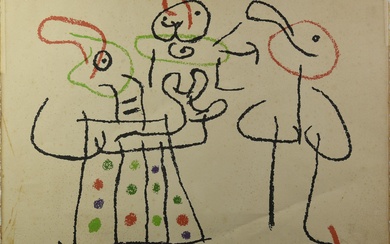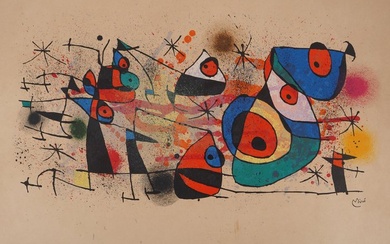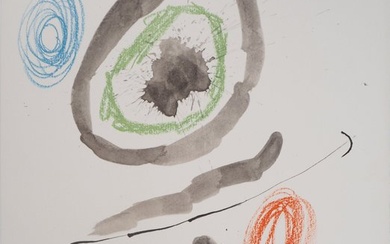JOAN MIRÓ (1893-1983) Le chanteur d'opéra
JOAN MIRÓ (1893-1983)
Le chanteur d'opéra
signed and numbered 'Miró 1/6' (lower right)
iron and bronze with green patina
54.1cm (21 5/16in). high
Conceived in 1977, this bronze version cast by the Fundició Parellada in a numbered edition of 6.
The authenticity of this work has been confirmed by the Association pour la Défense de l'oeuvre de Joan Miró (ADOM).
Provenance
The artist's estate.
Acquired from the above by the present owner.
Literature
F. Basile & J. Dupin, Joan Miró, Vedi alla voce sogno, Bologna, 1997 (another cast illustrated p. 259).
Exh. cat., Miró. Später Rebell, Vienna, 2001, no. 54 (another cast illustrated p. 170).
E. Fernández Miró & P. Ortega Chapel, Joan Miró, Sculptures. Catalogue raisonné, 1928-1982, Paris, 2006, no. 352 (illustrated p. 330).
I feel myself attracted by a magnetic force to an object, and then I feel myself being drawn towards another object which is added to the first, and their combination creates a poetic shock – which makes the poetry truly moving, and without which it would have no effect.
- Joan Miró in a letter to Pierre Matisse, 1936.
With its totemic gravitas and playful spontaneity, Le chanteur d'opéra forms a monument to the perpetuity of Surrealism, and of Miró's ever-lasting mark on this storied movement. Generating shifting references of the ancient, the comical and the Surreal, the present work harnesses the aesthetic of raw craftsmanship in order to reduce the human form to base architecture. The opera singer's body comprises an assemblage of geometric and found objects, its rough-hewn nature granting it the guise of an ancient ruin. The vertical iron nail to the top forms her sinuous neck, anchored by a horizontal bronze bamboo shoot encompassing her outstretched arms, as one can imagine her in the throes of her climactic aria. The square tablet forming her torso is offset by the flowing drapery cascading down her back and pooling at her base, evoking both her costume and the curtains of the stage. Together with her two exposed breasts – which resemble crumpled clothing – this drapery seems to recall the suggestive, delicate tactility of ancient Greek sculpture. The linear axiality of the entire composition also harks to primordial sculptural forms, as well as shamanic totems, which were a hallmark of Miró's 1970s oeuvre.
With his mastery of inventive fantasy, Miró threads together these visual layers, generating a vital discourse between the opera singer's disparate elements. Turning his focus toward the natural environment at the dusk of his career, he cast his objects in bronze, leaving the accidents of the plaster and his tools visible and allowing his creations to weather outdoors. He paid close attention not only to their compositions but also to their patinas, forever open to unexpected discoveries, in tandem with his philosophy of object-collecting. In alignment with his Surrealist peers, Miró was ingratiated with popular, folk and indigenous art forms, accumulating puppets, toys, African sculptures and pre-Colombian artefacts. He saw the true value of his plastic art in the miniature lives of each of these found objects, their manufactured yet chance encounters evoking a Surreal drama which is immortalised in bronze. Miró considered this theatre of the object to be the true essence of art – a gateway into 'a truly phantasmagoric world of living monsters' (Exh. cat., Joan Miró, Sculpture, London, 1989, p. 175).
View it on
Estimate
Time, Location
Auction House
JOAN MIRÓ (1893-1983)
Le chanteur d'opéra
signed and numbered 'Miró 1/6' (lower right)
iron and bronze with green patina
54.1cm (21 5/16in). high
Conceived in 1977, this bronze version cast by the Fundició Parellada in a numbered edition of 6.
The authenticity of this work has been confirmed by the Association pour la Défense de l'oeuvre de Joan Miró (ADOM).
Provenance
The artist's estate.
Acquired from the above by the present owner.
Literature
F. Basile & J. Dupin, Joan Miró, Vedi alla voce sogno, Bologna, 1997 (another cast illustrated p. 259).
Exh. cat., Miró. Später Rebell, Vienna, 2001, no. 54 (another cast illustrated p. 170).
E. Fernández Miró & P. Ortega Chapel, Joan Miró, Sculptures. Catalogue raisonné, 1928-1982, Paris, 2006, no. 352 (illustrated p. 330).
I feel myself attracted by a magnetic force to an object, and then I feel myself being drawn towards another object which is added to the first, and their combination creates a poetic shock – which makes the poetry truly moving, and without which it would have no effect.
- Joan Miró in a letter to Pierre Matisse, 1936.
With its totemic gravitas and playful spontaneity, Le chanteur d'opéra forms a monument to the perpetuity of Surrealism, and of Miró's ever-lasting mark on this storied movement. Generating shifting references of the ancient, the comical and the Surreal, the present work harnesses the aesthetic of raw craftsmanship in order to reduce the human form to base architecture. The opera singer's body comprises an assemblage of geometric and found objects, its rough-hewn nature granting it the guise of an ancient ruin. The vertical iron nail to the top forms her sinuous neck, anchored by a horizontal bronze bamboo shoot encompassing her outstretched arms, as one can imagine her in the throes of her climactic aria. The square tablet forming her torso is offset by the flowing drapery cascading down her back and pooling at her base, evoking both her costume and the curtains of the stage. Together with her two exposed breasts – which resemble crumpled clothing – this drapery seems to recall the suggestive, delicate tactility of ancient Greek sculpture. The linear axiality of the entire composition also harks to primordial sculptural forms, as well as shamanic totems, which were a hallmark of Miró's 1970s oeuvre.
With his mastery of inventive fantasy, Miró threads together these visual layers, generating a vital discourse between the opera singer's disparate elements. Turning his focus toward the natural environment at the dusk of his career, he cast his objects in bronze, leaving the accidents of the plaster and his tools visible and allowing his creations to weather outdoors. He paid close attention not only to their compositions but also to their patinas, forever open to unexpected discoveries, in tandem with his philosophy of object-collecting. In alignment with his Surrealist peers, Miró was ingratiated with popular, folk and indigenous art forms, accumulating puppets, toys, African sculptures and pre-Colombian artefacts. He saw the true value of his plastic art in the miniature lives of each of these found objects, their manufactured yet chance encounters evoking a Surreal drama which is immortalised in bronze. Miró considered this theatre of the object to be the true essence of art – a gateway into 'a truly phantasmagoric world of living monsters' (Exh. cat., Joan Miró, Sculpture, London, 1989, p. 175).







